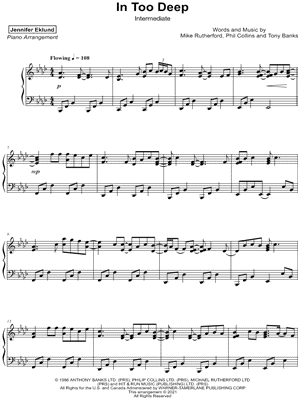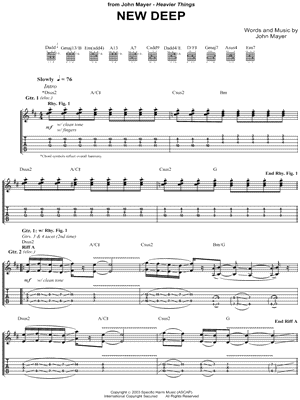Have you ever stopped to listen to a song and realized a sense of depth that goes beyond the surface melody? It’s like there’s a whole other world hidden beneath the notes, a secret language waiting to be deciphered. This is the magic of deep chords, those rich and complex harmonies that create a sense of emotional resonance and sonic texture unlike anything else in music.

Image: www.musicnotes.com
Deep chords are more than just a technical concept; they are the foundation of musical expression. They allow musicians to paint complex emotions, evoke vivid imagery, and create unique soundscapes that can transport listeners to different worlds. Whether it’s the driving bass lines of a bluesy rock song, the shimmering arpeggios of a classical masterpiece, or the soul-stirring chords of a gospel choir, the power of deep chords underlies every genre and every musical emotion.
Unveiling the Basics: Understanding Deep Chords
Beyond Triads: Expanding the Musical Palette
Let’s start with the basics. When you think of a chord, you probably imagine a triad, the building block of harmony. Triads are simple combinations of three notes, like C major (C-E-G) or A minor (A-C-E). But, the world of music doesn’t stop there. Deep chords delve deeper, adding more notes to create a richer, more complex sound.
For instance, a major seventh chord adds a fourth note to a major triad: C major seventh (C-E-G-B). This extra note adds a sense of tension and resolution, creating a more sophisticated sound. Similarly, minor seventh chords (C minor seventh (C-Eb-G-Bb)) introduce a melancholic quality, lending themselves to a range of emotional expressions.
Stacked Harmony: Building Layers of Sound
Deep chords often involve stacking notes in a specific way to create unique sonorities. This stacking, or voicing, is a crucial aspect of understanding the depth of a chord. You can think of it like creating different layers in a musical tapestry.
For example, a C major chord can be played in different ways, such as with the bass note on the bottom (C-E-G) or with the third on the bottom (E-G-C). These different voicings affect the sound’s character, ranging from warm and mellow to bold and powerful.

Image: www.musicnotes.com
Adding Color: Incorporating Extensions and Alterations
The world of deep chords expands even further with the addition of extensions and alterations. Extensions add notes that are beyond the basic seventh chord, like a ninth (C major ninth (C-E-G-B-D)), eleventh (C major eleventh (C-E-G-B-D-F)), or thirteenth (C major thirteenth (C-E-G-B-D-F-A)). These extensions add more color and complexity, leading to richer harmonies and more unique sounds.
Alterations, on the other hand, change the quality of the individual notes within a chord. For example, a flatted fifth (F) in a C major chord (C-Eb-G-B-F) creates a dominant seventh chord (C7), adding a bluesy and edgy flavor. These alterations are often used to add sophistication, tension, and surprise to musical phrases.
The Journey into the Deep Chords: A Historical Perspective
Deep chords have been a part of the musical landscape for centuries, evolving alongside musical styles and instrumentation. It’s impossible to trace their origins back to a single point in history, as they emerged organically within the progression of musical development.
Ancient Roots: Early Forms of Harmony
Even ancient civilizations, like those in Mesopotamia and ancient Greece, utilized rudimentary forms of harmonic progressions that hinted at the beginnings of deep chord structures. Their vocal music, and instruments like the lyre, created sounds that, while simple compared to modern harmonies, involved stacked notes and rhythmic relationships that foreshadowed the complex harmonies we see today.
Medieval and Renaissance: Expanding Horizons
The medieval period saw the development of modal scales and liturgical music, where different melodies were sung simultaneously, creating basic forms of harmonies. By the Renaissance, composers like Josquin Desprez and William Byrd explored increasingly complex polyphony, incorporating multi-part harmonies that laid the groundwork for the later exploration of chord progressions.
Baroque Era: A Symphony of Sounds and Chords
The Baroque era, with its emphasis on grandeur and emotional depth, saw the emergence of the “figured bass” system, where symbols were used to indicate the chords to be played in a piece. Composers like Johann Sebastian Bach, George Handel, and Antonio Vivaldi experimented with elaborate harmonies, introducing inversions, suspensions, and other techniques that added complexity and depth to their music.
Romantic Era: Emotional Expressiveness Through Chords
The Romantic era, characterized by its emphasis on emotion and individualism, saw the further exploration of rich and dramatic harmonies. Composers like Franz Schubert, Robert Schumann, and Johannes Brahms utilized complex chord progressions, modulations, and chromaticism to express a wide range of feelings, from joy and love to despair and longing.
20th Century and Beyond: Breaking Boundaries
The 20th century saw music break free from traditional harmonic structures, allowing for a wider range of experimentation with chords. Composers like Igor Stravinsky, Arnold Schoenberg, and Béla Bartók challenged the established norms, creating new and often avant-garde approaches to harmony.
Jazz, born in the early 20th century, became a breeding ground for sophisticated chord progressions, employing a wide range of chords and chord substitutions to achieve improvisational and expressive freedom. Blues music, with its emphasis on minor chords, extended chords, and altered chords, added a unique emotional depth and raw energy to popular music.
The Digital Age: Expanding the Possibilities
In the digital age, music technology has given composers and producers unprecedented control over sound. With the help of synthesizers, samplers, and computer software, musicians can create and manipulate sounds in ways that were previously unimaginable. This allows for a greater exploration of deep chord structures, with the ability to create exotic harmonies and textures that push the boundaries of traditional music.
The Art of the Deep Chord: Beyond Technicality
Understanding the theoretical aspects of deep chords is only part of the story. The real magic lies in the ability to use those chords to create music that touches the heart and soul. Masterful composers and musicians have a deep understanding of the emotional power that each chord can evoke.
Crafting Emotions: The Psychology of Sound
Deep chords have the power to evoke a wide range of emotions, from joy and excitement to sadness and longing. The human brain is wired to respond to specific harmonies in a way that triggers emotional responses. Major chords often feel uplifting and optimistic, while minor chords can create feelings of melancholy, nostalgia, or even tension.
The key lies in the skillful manipulation of chord progressions, the way chords are sequenced and resolved. A simple progression of major chords can be uplifting and joyful, while a progression that moves through minor, dominant, and seventh chords can build tension, intrigue, and even resolve beautifully.
A Soundtrack for Our Lives: The Storytelling Potential of Deep Chords
Deep chords are not just sound effects; they are the building blocks of musical storytelling. By manipulating the harmonic landscape, composers can guide the listener through a journey of emotions, building tension and release, introducing conflict and resolution, and ultimately telling a story without words.
Imagine the power of a classical composer starting a piece with a melancholic minor chord progression, evoking a sense of loss or longing, then shifting to a warmer, major chord sequence to express hope or redemption. Or think of a rock band using a series of extended chords to create a sense of raw energy and power before resolving beautifully into a comforting major chord, leaving the listener with a satisfying feeling of release.
Into The Deep Chords
Exploring the Depths: Further Adventures in Harmony
This exploration into deep chords is just the tip of the iceberg. The world of music is vast and filled with infinite possibilities. There are countless chord structures, inversions, alterations, and techniques that can be explored.
If you’re inspired to delve deeper, consider the following:
- Take music theory lessons: Studying music theory can equip you with the tools and knowledge you need to understand and apply deep chords effectively.
- Experiment with different chords and progressions: Try different chord combinations on instruments or using music software to create your own unique sound.
- Listen to your favorite musicians: Pay attention to the chord progressions used in your favorite songs and try to identify the deeper structures that create specific emotions.
- Explore different genres: Immerse yourself in various musical genres to discover how deep chords are used in different styles and contexts.
The journey into deep chords is a journey of constant discovery. As you explore the intricacies of harmony, you’ll unlock a deeper understanding of the music you love and gain the tools to create your own musical expressions. So, dive deep and let the music take you on a captivating journey into the depths of sound.





